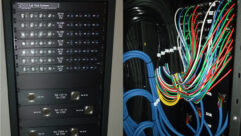
Say What You Mean
From the pet shop to the post office, from subway stations to stadiums, digital signage seems to be everywhere. And the people who own, program, and stand to profit from such networks are relying increasingly on sophisticated content management systems to assure the right message gets to the right screen at the right time.
The Creative ChallengeDid It Run? Did It Work?Opportunity Awaits
The U.S. Postal Service has implemented digital signage in many of its post offices to deliver basic information, marketing messages, and other content. Here, visitors at the Church Street station in New York experience a number of signage interactions.
Credit: Courtesy of Symon Communications
From the pet shop to the post office, from subway stations to stadiums, digital signage seems to be everywhere. And the people who own, program, and stand to profit from such networks are relying increasingly on sophisticated content management systems to assure the right message gets to the right screen at the right time.
Content management for digital signage embraces three overlapping functions:
- Moving bits of data to where they’re needed
- Making sure those bits add up to high-impact communications
- Controlling the message and measuring its effect.
John Kirkpatrick, business development manager at 3M Digital Signage, Bainbridge Island, Wash., says most end users opt for one of three structures to distribute information to their displays. The first is to maintain a central server from which all remote content players can pull material at predetermined intervals. Option two is what he calls “cascading delivery,” in which content is routed to various regional locations, where local players then connect and download new content. Finally, users may choose an Internet backbone in which each store or site has an IP address, and content is delivered from an organization’s central server over the Internet. Individual players within the site pull their content streams from the local server.
“Most content management systems fall into two camps: self-hosted and Web-based,” says Bill Gerba, CEO of Wirespring Technologies, Fort Lauderdale, Fla., and editor of the Kiosk and Digital Signage blog. “Self-hosted systems reside on a user’s workstation or a departmental server and must be accessed via a regular Windows application. Web-based systems are either hosted on a company’s Web site or provided as an outsourced service, and can offer access to content management functionality via any computer connected to the Internet with a regular Web browser.”
Similarly, Kirkpatrick describes two approaches to content distribution that he calls the broadcast and IP models.
“One is automatable, and one is not,” says Kirkpatrick. “The broadcast video side requires an editor and high bandwidth. The IP side can be extremely efficient and automated, with very small connectivity requirements.” The two approaches, he says, “are still fighting it out, but the IP side is going to win in the long term.”
The choice among these strategies is strongly influenced by the size and complexity of the network. An installation with a limited number of displays that downloads new content once a week during off-peak hours may function quite well on a DSL or a single T1 line. Real-time streaming, frequent updates, high-definition video, and large numbers of displays that deliver different content all will heighten demand for bandwidth — often including multigigabit connections.
These connectivity pipes don’t have to rely exclusively on wires and cables, says Ronald Gross, chairman and CEO of Dynatek Media, a Scottsdale, Ariz., company that builds custom content for digital signage. Gross says his company distributes content to clients’ sites through a cellular network.
Whatever the vehicle, the network still delivers only bits. To move from a stream of data to an effective marketing tool requires several more steps. At minimum, both hardware and software must be able to deal with a wide variety of file types and sources.
Kirkpatrick points out that the same digital signage network can make use of Flash animations, QuickTime movies, MPEGs, and other types of files.
“The content management software has to be able to handle all standard file formats in an automated way,” he says. “They can’t require conversion to a proprietary format.”
NOT JUST IN-STORE TELEVISION
Digital signage may look like TV. It displays on a plasma or LCD screen and often includes high-quality video. But experts say thinking of signage as “in-store television” can lead to disappointment.
“The majority of people in digital signage have tried [to use TV spots] and they look terrible,” says Ronald Gross, chairman and CEO of Dynatek Media in Scottsdale, Ariz. “In no case so far have we been able to transport a TV ad and not had to redo it.”
For one thing, says Gross, digital signage displays may have no audio at all or audio of a very different kind from what is typical in TV commercials. Another factor is time: Rarely can a digital signage application use a standard 30-second TV spot. Instead, the running time of digital signage ads will vary, depending on an evaluation of the usage environment and customer/viewer behavior. “You can’t just take a 30-second spot, chop it up, and have it work,” says Gross.
Moreover, John Kirkpatrick of 3M Digital Signage in Bainbridge,Wash., says getting away from the TV “look” can be critical to success in signage. “If it looks like TV, it gets one-third the message retention it would if it looked like a poster,” he says of messages displayed on signage systems. Often, he explains, creative digital signage users may install their displays in portrait orientation rather than landscape. “Our minds register that screen completely differently” from TV, says Kirkpatrick, noting that assets may be formatted for horizontal screens and require adaptation to work well in the new aspect ratio.
He adds that new display options, such as projection screens, can be cut and shaped in very intricate and eye-catching ways, which work against any ordinary adaptation of a television image.
“You can schedule and repurpose content to really achieve a non-television format,” he says.
A content management system must give users powerful ways of creating content from the often-enormous volume of assets at their disposal. This content, in turn, determines how to address bandwidth, file format, and similar network issues.
Any organization with a significant marketing program will discover quickly that it has accumulated a vast amount of potentially useful material, from point-of-sale posters to brochures, from logos to Web site graphics to high-quality video. Locating all these resources, accessing them, and bringing them together for new purposes is a central function of content management.
“Content management starts with being able to store and categorize content according to a set of rules, such as what a particular piece of content is (an advertisement, news reel, etc.), along with copyright information and subjective metadata or tags that let you add additional specifications,” says Gerba. “This information allows a large amount of content to be stored and quickly searched, categorized, and sorted.”
Keeping track of all of this can be a challenge. Most content management systems feature some kind of library. “More sophisticated offerings allow the user to search, sort, and tag content with different characteristics to make managing large amounts of content easier,” says Gerba.
Automation and standardized file formats are also key, says Kirkpatrick.
“The first level of stepping up into digital signage content management software is to be able to schedule multiple forms of content to run together,” he says. “PowerPoint, Flash, Web site content, video —none of these files work happily together unless you have good management software. You can’t switch between them with just a mouse click.”
Repurposing other content for digital signage can be an appealing strategy, especially for newcomers and the budget conscious. But experts warn it can be risky.
“Even if you have a marketing department, this is a different beast,” says Alison Clifford, manager of contract services at Planar Digital Signage, Beaverton, Ore. “It’s not print, and it’s not video. It’s an animated poster.”
The creative mandate begins with getting attention, and that begins with a hard look at the setting in which signage will be used.
“We usually take a cue from the client about how long a customer is going to be on the premises,” says Clifford. “Banking clients tend to think in terms of how long the queue is going to be, for example.” This duration of exposure dictates how many messages can be routed to displays, how long they should be, and how often they should repeat.
Gross also emphasizes getting an accurate fix on this viewer “dwell time.” In a convenience store, for instance, a customer may be present for four minutes. In a drug store, he may have 15 or 20 minutes inside, while in a doctor’s waiting room, he may have as much as an hour or more, says Gross.
“If your model is to make money from ad revenue, you need to guarantee advertisers that they are going to be seen by every single visitor who comes through,” he says.
While content management systems must support creating effective messages from diverse raw material, they must also control who is authorized to request new content and get it made, approved, and distributed.
“Some people may be authorized to add content to a library but not delete it,” says Gerba. “Others may have the ability to review and approve content, but not schedule it for use anywhere.”
Regional managers may have limited authority to adapt content from enterprisewide templates, for example, by inserting their own special sales prices or by dropping promotions for products that run out of inventory at specific locations. With exceptions such as these, most organizations try to keep some degree of centralized control over what is distributed over their signage networks.
Of course, the value of a digital signage network, or its much-discussed return on investment, hinges on the messages being displayed, seen by an audience, and translated into tangible business results. This is the third arena in which content management systems make a major contribution.
First question: Did the spots play when they were supposed to?
“Content management means being able to get the right content to the right player at the right time, and being able to make sure and report on what you’ve done,” says Tim Detota, director of visual solutions at Symon Communications, Plano, Texas.
Bob Brittan, Symon’s director of product marketing, adds that this task requires “a mechanism to see what’s playing and proof of play reporting.” According to Brittan, in the advertising world, the proof of play requirement is satisfied when the advertiser gets a report, sometimes called an affidavit, stating that its content has played at particular time slots. His company’s system, for example, provides thumbnail displays of what is playing on remote screens.
At Dynatek Media, Gross says his company’s network lets it “remotely manage every single unit, turn them on and off, reboot, and an automatic call comes back to us if anything fails.”
Gerba says that, in general, a content management system may have built-in playback logging, or have export playback logs that can be imported into a spreadsheet or reporting tool.
“There are also third-party services that will take playback reports and do some intelligent analytics to see if they can detect patterns between playback and purchase,” he says.
This is what Detota calls the analytical side. “We are able to tie point-of-sale information to the content that was playing,” he says. “Customers have gathered the data that our players were exporting, compared it to their POS terminals, and determined if the content created an increased lift.”
Changing messaging quickly to respond to circumstances is also a common goal, says Lisa Duckett of Planar.
Some digital signage systems today, for example, can be controlled interactively using a portable touchscreen, she says, making it easy for a manager to decide on a change of strategy and put that change into effect immediately. Functions such as this are part of content management’s future, even if they’re not fully operational today. “It’s still early,” says Duckett. “I wouldn’t say the software packages are all completely mature yet.”
In fact, many end users expect content management to be part of the deal when they contract for a digital signage installation.
Even though content management software is easy to use, clients often expect someone else to manage their networks for them, creating opportunities for AV integrators.
“Management can be outsourced to an AV integrator that can support it,” says Kirkpatrick. “I know several integrators that manage a dozen or so networks. It’s a great recurring revenue source for them.”
Detota says content management is definitely an area of opportunity for the integrator that wants to step up to the plate and offer reliable service. “The industry is still new and fresh,” he says, “and there’s plenty of opportunity to make a splash.”
John McKeon is an independent consultant and writer in Washington. He can be reached at [email protected].










